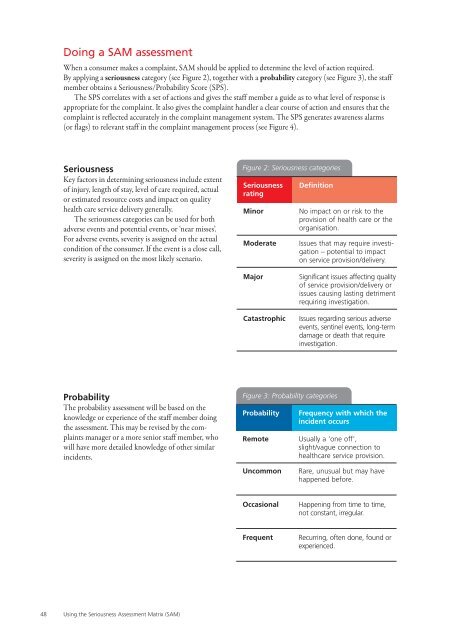Guide to Complaint Handling in Health Care Services
Guide to Complaint Handling in Health Care Services
Guide to Complaint Handling in Health Care Services
You also want an ePaper? Increase the reach of your titles
YUMPU automatically turns print PDFs into web optimized ePapers that Google loves.
Do<strong>in</strong>g a SAM assessment<br />
When a consumer makes a compla<strong>in</strong>t, SAM should be applied <strong>to</strong> determ<strong>in</strong>e the level of action required.<br />
By apply<strong>in</strong>g a seriousness category (see Figure 2), <strong>to</strong>gether with a probability category (see Figure 3), the staff<br />
member obta<strong>in</strong>s a Seriousness/Probability Score (SPS).<br />
The SPS correlates with a set of actions and gives the staff member a guide as <strong>to</strong> what level of response is<br />
appropriate for the compla<strong>in</strong>t. It also gives the compla<strong>in</strong>t handler a clear course of action and ensures that the<br />
compla<strong>in</strong>t is reflected accurately <strong>in</strong> the compla<strong>in</strong>t management system. The SPS generates awareness alarms<br />
(or flags) <strong>to</strong> relevant staff <strong>in</strong> the compla<strong>in</strong>t management process (see Figure 4).<br />
Seriousness<br />
Key fac<strong>to</strong>rs <strong>in</strong> determ<strong>in</strong><strong>in</strong>g seriousness <strong>in</strong>clude extent<br />
of <strong>in</strong>jury, length of stay, level of care required, actual<br />
or estimated resource costs and impact on quality<br />
health care service delivery generally.<br />
The seriousness categories can be used for both<br />
adverse events and potential events, or ‘near misses’.<br />
For adverse events, severity is assigned on the actual<br />
condition of the consumer. If the event is a close call,<br />
severity is assigned on the most likely scenario.<br />
Figure 2: Seriousness categories<br />
Seriousness<br />
rat<strong>in</strong>g<br />
M<strong>in</strong>or<br />
Moderate<br />
Def<strong>in</strong>ition<br />
No impact on or risk <strong>to</strong> the<br />
provision of health care or the<br />
organisation.<br />
Issues that may require <strong>in</strong>vestigation<br />
– potential <strong>to</strong> impact<br />
on service provision/delivery.<br />
Major<br />
Catastrophic<br />
Significant issues affect<strong>in</strong>g quality<br />
of service provision/delivery or<br />
issues caus<strong>in</strong>g last<strong>in</strong>g detriment<br />
requir<strong>in</strong>g <strong>in</strong>vestigation.<br />
Issues regard<strong>in</strong>g serious adverse<br />
events, sent<strong>in</strong>el events, long-term<br />
damage or death that require<br />
<strong>in</strong>vestigation.<br />
Probability<br />
The probability assessment will be based on the<br />
knowledge or experience of the staff member do<strong>in</strong>g<br />
the assessment. This may be revised by the compla<strong>in</strong>ts<br />
manager or a more senior staff member, who<br />
will have more detailed knowledge of other similar<br />
<strong>in</strong>cidents.<br />
Figure 3: Probability categories<br />
Probability<br />
Remote<br />
Frequency with which the<br />
<strong>in</strong>cident occurs<br />
Usually a ‘one off’,<br />
slight/vague connection <strong>to</strong><br />
healthcare service provision.<br />
Uncommon<br />
Rare, unusual but may have<br />
happened before.<br />
Occasional<br />
Happen<strong>in</strong>g from time <strong>to</strong> time,<br />
not constant, irregular.<br />
Frequent<br />
Recurr<strong>in</strong>g, often done, found or<br />
experienced.<br />
48 Us<strong>in</strong>g the Seriousness Assessment Matrix (SAM)

















